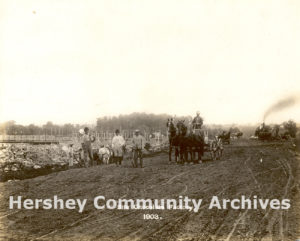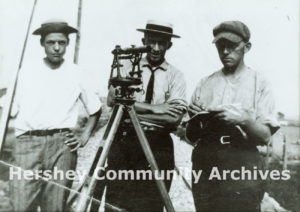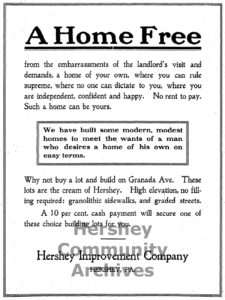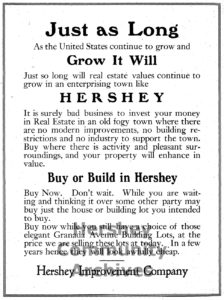Hershey Improvement Company: Build or Buy a Home in Hershey

In 1903, when Milton Hershey broke ground for the Hershey Chocolate factory in Derry Township his plans far exceeded the construction of one building. Mr. Hershey envisioned the development of a new community; a community that featured modern facilities and residences with the objective of being an “ideal twentieth century town.” [i]
Hershey Improvement Company, an unincorporated organization that operated under the auspices of the Hershey Chocolate Company, was responsible for building the infrastructure for Mr. Hershey’s model industrial town. The Improvement Company laid out roads, sidewalks, and all of the utilities including: water, sewer, electric, and gas. The company oversaw the construction of public buildings and homes as well as all real estate transactions.
Potential residents had the choice of purchasing a lot from the Improvement Company and building their own home or purchasing a home constructed by the company. Between 1911 and 1915, the company constructed 150 homes. The benefits and convenience of indoor plumbing and electricity were advertised to homeowners however an emphasis was placed on the community’s amenities:
It is the town of health; it is a paradise for children. Its great public school with everything free is a wonderful asset. It has free libraries, playgrounds, gymnasiums, clubs and all the merits of a place many times its size. These give value that mean dollars and cents to the home investment. The man who buys or builds a home not only gets the full value of that property but the additional value of the town improvement and equipment.
- Hershey Press, Advertisement, 11/5/1914.
The company’s investment in the community’s infrastructure was the homeowner’s advantage. This idea exemplified the progressive ideal of capitalism and wealth being used to raise the standard of living for all.
The economic value of home-ownership, to the individual, was also emphasized in the Improvement Company’s real estate advertisements. “Property owners in Hershey are enabled to sell their property, if they so desire, making quick sales, and selling at a considerable price over their original investment… We can cite you several instances of property holders in Hershey that have sold their properties recently and pocketed a nice profit.” In this respect, Hershey’s model industrial community was unlike those that preceded it.
For comparison, consider another celebrated company town, Pullman, Illinois.
In 1881, the first residents moved into Pullman, Illinois, a community just outside of Chicago founded by railroad car manufacturer George M. Pullman. Pullman was considered to be an ideal town that offered many of the amenities that would later be available in Hershey, Pennsylvania. An important difference between the two communities was home ownership.
In Pullman, residents were unable to buy their homes, they could only rent. Following the economic depression of 1893, the Pullman Company laid off workers and reduced wages but refused to lower rents. Workers went on strike and the community became associated with industrial strife, far short of the ideal. By 1900, the municipal functions of the community had been assumed by the city of Chicago.[i]
It is likely Milton Hershey was aware of the downfall of Pullman and planned and organized his businesses and community with these lessons in mind. He planned for a model industrial community that would remain an ideal. “Hershey’s future is clearly established….Hershey is the model industrial town that is developing into the model home town, and in the course of another decade it will attract thousands of people.”[iii]
Hershey Improvement Company continued to oversee the development and expansion of the Hershey community until Hershey Chocolate Company was reorganized in 1927. After the reorganization, responsibility for the management and development of the community’s infrastructure was placed under the newly created Hershey Estates.
[i] “Big Building Boom in the Chocolate Town.” Hershey Press, 31 August 1911.
[ii] Green, Hardy. The Company Town: The Industrial Edens and Satanic Mills That Shaped the American Economy. Basic Books: New York, 2010.
[iii] “Advertisement.” Hershey Press, 5 November 1914.



